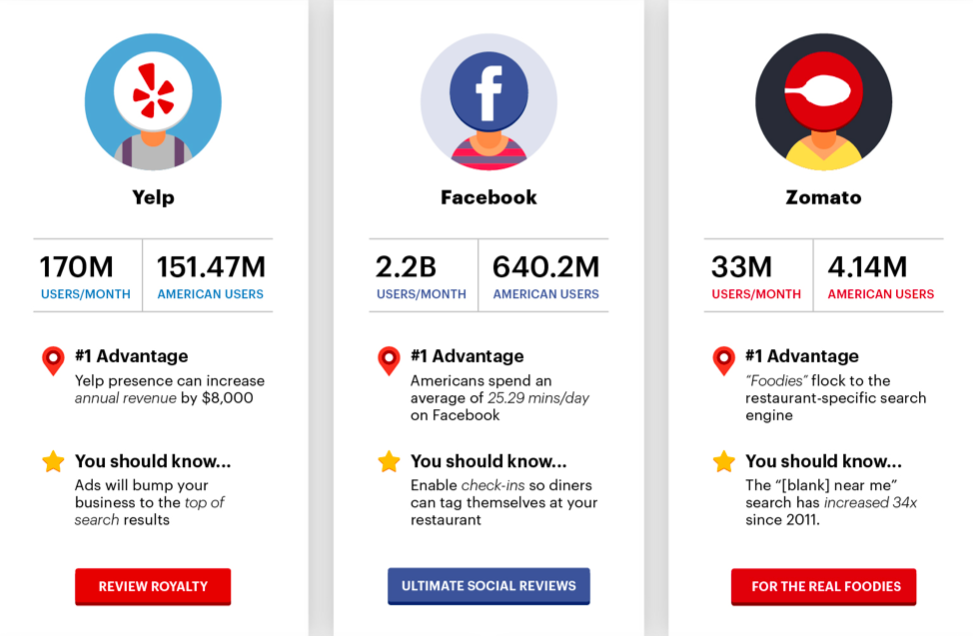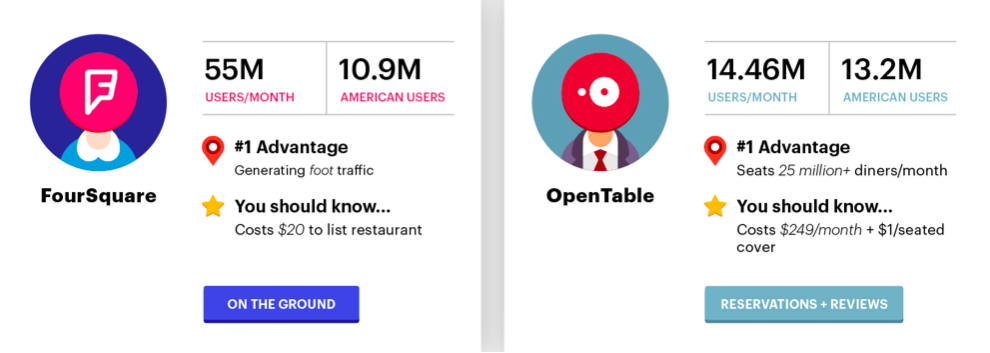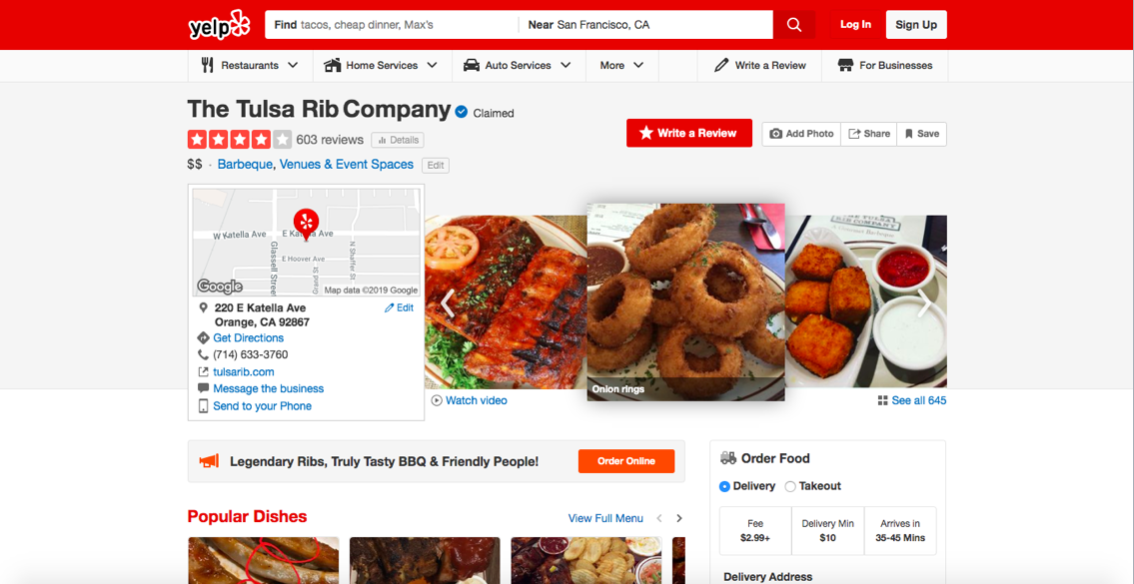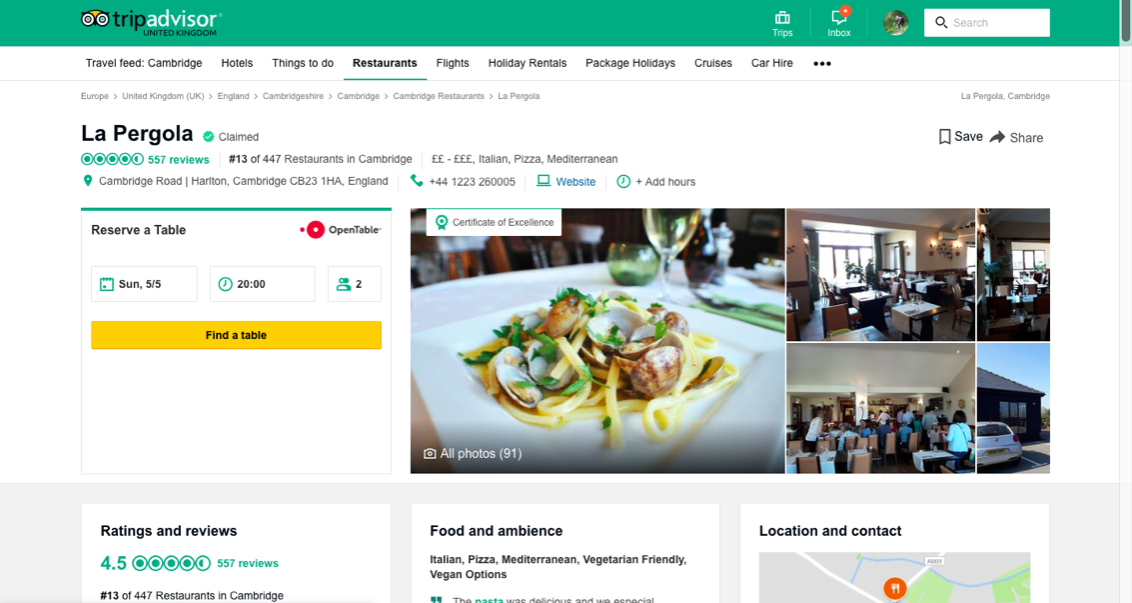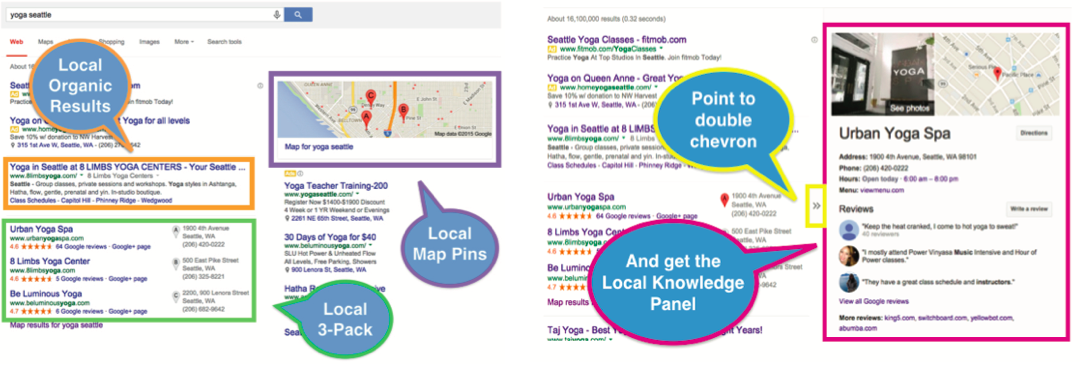Top 3 Digital Marketing Strategies for Restaurants
Social Media
Here’s the process to create a profile.
create a page - choose 'local business or place’
add a profile picture
add a cover photo
add a short description
create a username
add a call-to-action button
choose your page tabs
set up roles - including:
`admin
editor
moderator
advertiser
analyst
live contributor
verify your page
Posting content is the core of Facebook marketing. Post types include:
images
links
video
Facebook Live
Here’s a guide to strategy on Facebook.
identify your audience
location
age
gender
income
interests
evaluate your competitors
visual quality
post frequency
content mix
engagement on posts (likes, comments, shares)
response time and quality
create a content calendar
scheduling posts
best frequency and timing
get likes and fans
generating leads
creating events
Facebook advertising is highly effective. According to studies, 96% of social media marketers consider Facebook the most effective social media advertising platform. You can start with just a hundred dollars. Each click on your ad could be just $0.10-$0.30, to get a new lead. It’s simple to set up and gets fast results. You can reach your perfect audience with highly detailed targeting, based on their interest, demographics, location, and behaviour.
The campaign structure consists of:
campaign
ad set
ad
Here are the steps to set up campaigns:
step 1: select your campaign objective
step 2: give your ad campaign a name
step 3: set up your audience targeting
step 4: set up your ad placement
step 5: set up your campaign budget and bidding
step 6: set up your Facebook ads
Ad types include:
traffic and leads to your website
sales and leads for your product or service
likes and engagement of your page
visitors to your venue or event
Determine the audience and targeting. Targeting options include:
location-based targeting
country
state/region
counties
DMA (Designated Market Area)
city
postal code
specific address radius
demographics-based targeting
age
gender
language
interest-based targeting
behaviour-based targeting
Determine ad settings.
budget
daily budget
lifetime budget
schedule
run continuously
set a start and end date
Here’s the process to create a profile.
add your bio / description
add your profile picture
add your link
Determine content themes. Content themes could include:
behind the scenes content
user generated content
product demo / showcase
educational
culture focused
fun / lighthearted
customer stories
get to know the team
Create a content plan. A content plan includes these elements:
style guide
composition
color palette
fonts
filters
captions
hashtags
Here’s a guide to strategy on Instagram.
key elements
clear vision and strategy
consistent frequency
familiarity with your audience
clear visual style
choose main goals
showcase your products or services
build your community
increase awareness of your brand
showcase your company culture and values
advertise to potential customers
increase brand loyalty
share news and updates
research the demographics
age
gender
location
education
income
best frequency and timing
Instagram advertising offer a seamless experience for users, and Instagram ads appear in a bold linear format for visual inspiration. It’s a great way to drive awareness, increase customers, and share your story amongst a highly engaged audience.
Here are the steps to set up campaigns via the Facebook Ads Manager:
create a business page and profile
set up your ad
placement
feed
stories
determine your budget
publish
You can also set up campaigns via the Instagram app.
Ad formats include:
photo ads
video ads
carousel ads
collection ads
stories ads
Determine the audience and targeting. Targeting options include:
location
demographics
interests
behaviours
Review Sites
World of mouth is nothing new. You provide customers with an experience, they talk to their friends about that experience, then those people either choose to visit your restaurant or stay away. Restaurant review sites are just like world of mouth through a big megaphone. Most restaurant-goers regularly look at online reviews to help them make decisions about where to eat. 68% of people said they tried a new restaurant based on positive online reviews. 45% off people check online reviews before deciding on a new restaurant. 67% of millennial restaurant-goers look at reviews before deciding on a new restaurant.
The reasons to claim your business on review sites include:
be found
boost search rankings
build relationships with customers
improve your business
There are various review sites, including:
Zagat
Trip Advisor
Google
Yelp
Facebook
Zomato
Foursquare
Open Table
Here are the best practices when it comes to responding to reviews.
When responding to positive reviews, don’t get overly confident. Rather than basking in the glory of a positive feedback, here’s your opportunity to show you’re a humble, hard-working restaurant operator who appreciates customer loyalty. Thank your reviewer for visiting your business and sharing their experience. Invite that person to come back again and encourage them to bring some friends. When responding to Yelp reviews, you want to come off as grateful and genuine. The key is to keep it short, sweet, and simple. By responding to a positive review, you’re thanking your reviewer for taking the time to do something nice of your business. And if other users see that, they may be inclined to do the same. You response might go something like this:
“Thank you so much for your kind words. I’m glad you enjoyed our pasta special; it’s one of my favourites. We hope to see you again soon.”
A negative review is no reason to panic. When you get a negative review, your first move should always be to respond to your reviewer privately, as opposed to publicly. If you want to turn that negative review into a more positive tone, bite your tongue and take your response offline. Before you craft your response, do your research. Read the review carefully and investigate the incident the reviewer alludes to. The last thing you want to do is make excuses or get defensive. Rather your goals should be to: apologise for the customer’s negative experience, and ask the customer for a chance to make things right. Don’t explain lengthy personal details to do with your chef or staff. None of that matters. You need to make it clear that what your viewer experienced was an unfortunate exception, not the rule, and that you’re confident you can do better. If a private response doesn’t yield any results (meaning your reviewer ignores you, responds rudely, or leaves his review unchanged), then consider responding publicly. Here you want to be polite and to the point. The more level headed and respectful you come off, the ore users might start to question the reviewer, as opposed to your restaurant. Your response to a negative review might go something like:
“I’m sorry you felt your steak was overcooked and under-seasoned. Usually our customers rave about that particular dish, so I apologise if our kitchen had an off night. We’d love for you to come back and try some of our other mains.”
Yelp
Approximately 142 million visitors turn to Yelp each month to read up on local businesses. Yelp is now home to about 100 million reviews. It’s no wonder people people turn to yelp in choosing restaurants.
To create a profile, you need to either claim your business, or create your listing. The basics include:
your business name
address and contact info
your restaurant’s hours
the category (e.g. diner, pizzeria, etc.)
Then, verify your business, and delete duplicates.
To optimise your page, add photos, and detailed business info, including:
have gluten-free menu options
provide wi-fi
accept mobile payments
provide bicycle parking
provide customer parking
Yelp encourages restaurant owners to invest in their advertising program. Users are more likely to convert into customers with a gentle push from targeted ads and an upgraded business profile. You have a choice between:
branded profile - includes photo slideshow, video, and a call to action feature
enhanced profile - includes all the features of a branded profile, including the removal of competitor ads
Trip Advisor
With 4.9 million restaurants and counting, Trip Advisor sees millions of travellers every month research and plan their trip. But did you know that Trip Advisor is used by locals, too? Over 200 million people on average search for restaurants on Trip Advisor each month. And apparently, 86% of users have opted to dine at a restaurant as a result of a Trip Advisor ranking, review, rating or award.
To create a profile, you need to either claim your business, or create your listing.
To optimise your profile, add photos, and detailed business info, including:
contact information
hours
cuisines
meals served
meal price range
amenities
You can further optimise your profile, by:
get your listing not he map
add your menu
integrate reservation links
allow users to order delivery
show your stickers and honours
add a widget to your site
You can pay for advertising with Trip Advisor Premium and Trip Advisor Ads.
You can gain a competitive advantage with Trip Advisor Premium for restaurants. Upgrading to Trip Advisor Premium allows restaurant owners to effectively curate their brand on the platform, so that you can enhance and differentiate your restaurant’s page. Features include:
Storyboard
Top 3 Reasons to Eat Here
Favourite Review
Local SEO
Why is local SEO so important?
125 million US consumers with smartphones
7 billion monthly local searches
78% of local searches on mobile and 61% of local searches on laptop result in offline purchases
#1 category of all local searches are for restaurants
Why should you optimise for local? Because you want to have a presence on:
local organic results
local 3-pack results
local map pins
local knowledge panel
What is typically searched for locally?
to locate an address
to search for a business with certain product or service
to find a phone number
to discover hours of operation
to get driving directions
to find coupons and special offers
to read ratings and reviews
Google My Business
The first step is to sign up with Google My Business to generate your business listing and business profile on Google.
Citations
The most important step in any local SEO strategy is getting citations in local directories. A local citation is a mention of your business on any webpage other than your own.
NAP is the common acronym used when talking about citations. It’s important that your NAP needs to be listed exactly the same everywhere. Consistency is important! NAP consists of:
name
address
phone number
categorisation
Where you should be listed:
local search engines
Google Places
Bing Places
Yahoo Local
Yelp
Yellow Pages
Foursquare
social media sites
Facebook
Twitter
Google+Instagram
local blogs
local directories and newspapers
Optimise Pages
After you have listed your citations and submitted to local directories, what you should do next is optimise your website pages. This includes three elements:
keyword title tags
NAP in HTML
local website content
As mentioned before, keywords are very important. Expand your keyword list to optimise for local SEO, by deciding your #1 keyword based on your restaurant concept and then add your location. For example, Organic Food and Cafe in New York.
As we said before, having a consistent NAP (name, address, and phone number) is vital. Make sure that this information is included in the HTML of your website. Make sure this information is not in image format, which Google and Bing don’t recognise. It should be in text format.
Having site content that is specialised to your city is a great way to boost your local search rankings.
Read More
Digibites is a digital agency for Bars, Cafes, and Restaurants. We specialise in digital marketing and creative solutions that will get new customers to your door and keep customers coming back.
Our services include: consulting, online marketing, website design, branding & graphic design. We also provide an online course.



